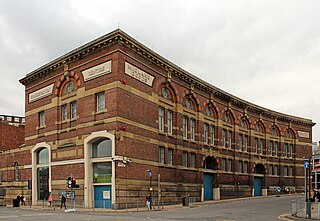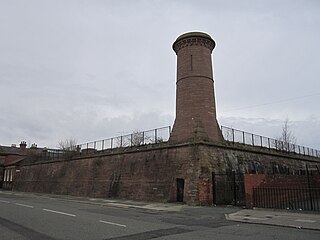
Tate Liverpool is an art gallery and museum in Liverpool, Merseyside, England, and part of Tate, along with Tate St Ives, Cornwall, Tate Britain, London, and Tate Modern, London. The museum was an initiative of the Merseyside Development Corporation. Tate Liverpool was created to display work from the Tate Collection which comprises the national collection of British art from the year 1500 to the present day, and international modern art. The gallery also has a programme of temporary exhibitions. Until 2003, Tate Liverpool was the largest gallery of modern and contemporary art in the UK outside London.

The Merseyside Maritime Museum is a museum based in the city of Liverpool, Merseyside, England. It is part of National Museums Liverpool and an Anchor Point of ERIH, The European Route of Industrial Heritage. It opened for a trial season in 1980 before fully opening in 1984 and expanding in 1986. The museum occupies warehouse block D at the Albert Dock, along with the Piermaster's House, Canning Half Tide Dock and Canning Graving Docks.

The Royal Albert Dock is a complex of dock buildings and warehouses in Liverpool, England. Designed by Jesse Hartley and Philip Hardwick, it was opened in 1846, and was the first structure in Britain to be built from cast iron, brick and stone, with no structural wood. As a result, it was the first non-combustible warehouse system in the world. It was known simply as the Albert Dock until 2018, when it was granted a royal charter and had the honorific "Royal" added to its name.

Duke's Dock is a dock on the River Mersey, England, and part of the Port of Liverpool. It is in the southern dock system, connected to Salthouse Dock and Wapping Dock to the east. The Albert Dock is located immediately north, although not directly accessible by water.

The National Conservation Centre, formerly the Midland Railway Goods Warehouse, is located in Liverpool, Merseyside, England. It stands in a block surrounded by Victoria Street, Crosshall Street, Whitechapel, and Peter Street. After it closed as a warehouse it was converted into a conservation centre for National Museums Liverpool in the 1990s. Initially its exhibition area was open to the public, but this closed in 2010. The centre is recorded in the National Heritage List for England as a designated Grade II listed building.
Walter Aubrey Thomas was an English architect who practised from an office in Dale Street, Liverpool. For his training he was articled to the Liverpool architect Francis Doyle, and established his independent practice in about 1876. His works consisted mainly of commercial buildings. He has been described as "the most individual Liverpool architect of the early 1900s". At least seven of his works are designated by English Heritage as listed buildings, and these are included in the list below, of which the most notable is the Grade I listed Royal Liver Building. Sharples and Pollard in the Pevsner Architectural Guides state that "his work shows admirable inventiveness and stylistic variety, as well as ambition matched by technological resourcefulness". In 1886, Walter Aubrey Thomas married Maud Paris. Her family were said to be of Greek extraction. Together, they had seven children: Walter Glegge, who died in 1907 at the age of 21. Louise (Lulu), followed by Dorrit, Winifred (Winsome), Edward (Bill), Oliver and Humphrey. Despite all of his commitments, W A Thomas appears to have been a good father. The boys were educated by home tutors and the girls were sent to Cheltenham Ladies College. The family home, designed by their father, was called Bleak House – now Brooke House – at Parkgate. Later, another house was built for them at Dunstan Wood. He died on the 13th September 1934. Great grandchildren include Sophie Thomas, Edward Thomas & Oliver Aubrey-Thomas

The International Slavery Museum is a museum located in Liverpool, UK, that focuses on the history and legacy of the transatlantic slave trade. The museum, which forms part of the Merseyside Maritime Museum, consists of three main galleries which focus on the lives of people in West Africa, their eventual enslavement, and their continued fight for freedom. Additionally the museum discusses slavery in the modern day as well as topics on racism and discrimination.

Sir James Allanson Picton was an English antiquary and architect who played a large part in the public life of Liverpool. He took a particular interest in the establishment of public libraries.

The architecture of Liverpool is rooted in the city's development into a major port of the British Empire. It encompasses a variety of architectural styles of the past 300 years, while next to nothing remains of its medieval structures which would have dated back as far as the 13th century. Erected 1716–18, Bluecoat Chambers is supposed to be the oldest surviving building in central Liverpool.
Mann Island is a small area in Liverpool, England. It lies on the waterfront next to the River Mersey between the Albert Dock to the south and the Pier Head to the north.

Liverpool is a city and port in Merseyside, England, which contains many listed buildings. A listed building is a structure designated by English Heritage of being of architectural and/or of historical importance and, as such, is included in the National Heritage List for England. There are three grades of listing, according to the degree of importance of the structure. Grade I includes those buildings that are of "exceptional interest, sometimes considered to be internationally important"; the buildings in Grade II* are "particularly important buildings of more than special interest"; and those in Grade II are "nationally important and of special interest". Very few buildings are included in Grade I — only 2.5% of the total. Grade II* buildings represent 5.5% of the total, while the great majority, 92%, are included in Grade II.

Liverpool is a city and port in Merseyside, England, which contains many listed buildings. A listed building is a structure designated by English Heritage of being of architectural and/or of historical importance and, as such, is included in the National Heritage List for England. There are three grades of listing, according to the degree of importance of the structure. Grade I includes those buildings that are of "exceptional interest, sometimes considered to be internationally important"; the buildings in Grade II* are "particularly important buildings of more than special interest"; and those in Grade II are "nationally important and of special interest". Very few buildings are included in Grade I — only 2.5% of the total. Grade II* buildings represent 5.5% of the total, while the great majority, 92%, are included in Grade II.

Liverpool is a city and port in Merseyside, England, which contains many listed buildings. A listed building is a structure designated by English Heritage of being of architectural and/or of historical importance and, as such, is included in the National Heritage List for England. There are three grades of listing, according to the degree of importance of the structure. Grade I includes those buildings that are of "exceptional interest, sometimes considered to be internationally important"; the buildings in Grade II* are "particularly important buildings of more than special interest"; and those in Grade II are "nationally important and of special interest". Very few buildings are included in Grade I — only 2.5% of the total. Grade II* buildings represent 5.5% of the total, while the great majority, 92%, are included in Grade II.

There are over 2500 listed buildings in Liverpool, England. A listed building is one considered to be of special architectural, historical or cultural significance, which is protected from being demolished, extended or altered, unless special permission is granted by the relevant planning authorities. Of the listed buildings in Liverpool, 27 are classified as Grade I listed and are recognised as buildings of outstanding architectural or historic interest. The following list provides information on all the Grade I listed buildings in the city.
There are over 2500 listed buildings in Liverpool, England. A listed building is one considered to be of special architectural, historical or cultural significance, which is protected from being demolished, extended or altered, unless special permission is granted by the relevant planning authorities. Of the listed buildings in Liverpool, 105 are classified as Grade II* listed and are recognised as being particularly important with more than special architectural or historic interest. Of these, 46 are located within the L1, L2 and L3 postcodes, which cover the city centre of Liverpool. The following list provides information on all the Grade II* listed buildings within these postcodes.
There are over 2500 listed buildings in Liverpool, England. A listed building is one considered to be of special architectural, historical or cultural significance, which is protected from being demolished, extended or altered, unless special permission is granted by the relevant planning authorities. Of the listed buildings in Liverpool, at least 85 are classified as Grade II* listed and are recognised as being particularly important with more than special architectural or historic interest. The following list provides information on all the Grade II* listed buildings located in all the L postcodes outside the city centre.

Merseyside is a metropolitan county in North West England. It was created by the Local Government Act 1972, and consists of the metropolitan boroughs of Knowsley, St Helens, Sefton, Wirral, and the city of Liverpool. Buildings are listed on the recommendation of English Heritage to the Secretary of State for Culture, Media and Sport, who makes the decision whether or not to list the structure. Grade I listed buildings are defined as being of "exceptional interest, sometimes considered to be internationally important"; only 2.5 per cent of listed buildings are included in this grade. This is a complete list of Grade I listed churches in the metropolitan county of Merseyside as recorded in the National Heritage List for England.
Culshaw and Sumners was a firm of English architects and surveyors who practised in Liverpool in the 19th and early 20th centuries. The work of the practice reflected the growing economic prosperity of the city during this period. Much of its work was routine and mundane, but it did produce some notable buildings, including office blocks, warehouses, domestic properties, workhouses, churches, and a hospital. The firm was established by 1839 by William Culshaw, who was joined by Henry Sumners in 1861. Following Culshaw's death in 1874, the practice was continued until 1916 by his son, Alfred.

High Park Reservoir is a disused reservoir in the Toxteth district of Liverpool, England. Water for the reservoir was enclosed in a brick-built, sandstone-clad building. The building still stands and is opened to visitors for special occasions and events.















